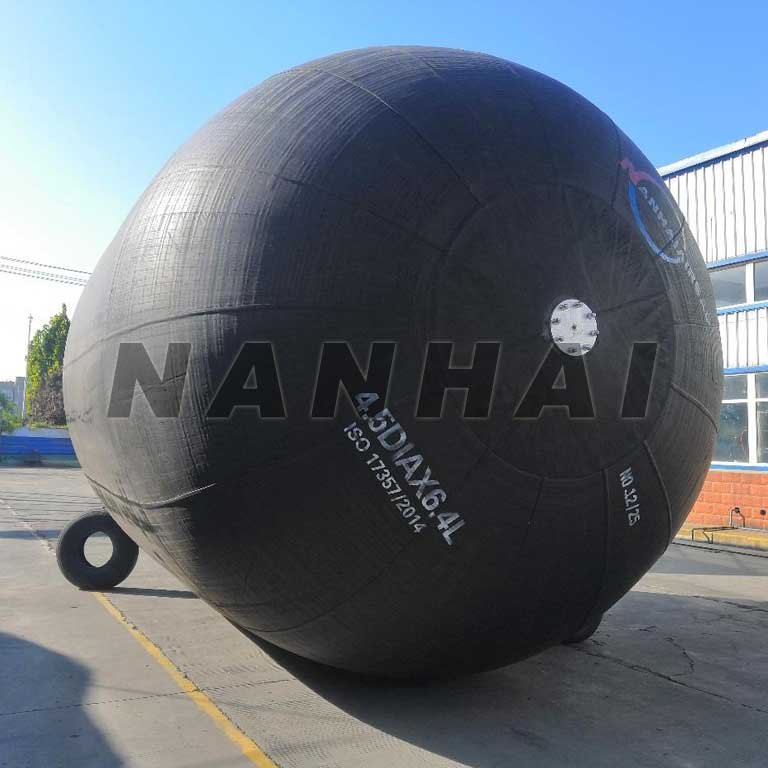Cell Fenders in United Arab Emirates
08/21/2025Yokohama Fenders in Indonesia: Reliable Protection for Vessels
08/22/2025Pneumatic Fenders Offshore CTN vs Sling Which Works Best
When it comes to offshore operations, choosing the right pneumatic fenders is critical for safety, efficiency, and protecting both vessels and offshore structures. Whether you’re dealing with STS (ship-to-ship transfers), FPSO operations, or long-term mooring, selecting the correct type can make a huge difference.
In the market, two main types dominate — CTN (Chain-Tire-Net) and sling type pneumatic rubber fenders. But which one works better offshore? Let’s break it down.
What Are CTN and Sling Pneumatic Fenders?
CTN pneumatic fender:
Designed with a protective chain-tire-net around the fender body, CTN models offer superior durability and abrasion resistance. They are the go-to choice for heavy-duty offshore operations, where fenders are frequently exposed to harsh conditions and high-contact scenarios, such as oil tankers, LNG carriers, and STS transfers.
Sling type pneumatic fenders:
These fenders don’t have the external tire-and-chain covering. They are lighter, easier to install, and less likely to leave marks on hull surfaces. Sling types are commonly used for smaller vessels, temporary berthing, or sensitive hull finishes like those on cruise ships or naval vessels.


Offshore Conditions and Technical Requirements for Pneumatic Fenders
Offshore environments are far more demanding than sheltered ports or harbors. Selecting the right pneumatic fender requires understanding both the challenges and specific usage scenarios:
Typical Offshore Usage Scenarios
- LNG carriers & terminals → Pneumatic fenders provide the high energy absorption needed to protect both vessels and jetties during loading and unloading operations.
- FPSOs (Floating Production, Storage, and Offloading units) → Used to safeguard both FPSOs and supply vessels during side-by-side mooring in open seas.
- Oil tankers & VLCCs → Heavy-duty CTN pneumatic rubber fenders are critical for safe mooring and STS cargo transfers.
- STS (Ship-to-Ship) operations → Pneumatic rubber fenders are widely used to absorb impact energy when transferring crude oil, LNG, or refined products between two vessels.
- Offshore platforms & supply vessels → Protects both the platform legs and supply vessels during frequent berthing in rough sea conditions.
Key Technical Challenges Offshore
- High waves and strong currents → Vessels move unpredictably, increasing the risk of collision.
- Heavy energy impacts → Large oil tankers, LNG carriers, and supply vessels often require fenders with very high energy absorption capacity.
- Long-term exposure → UV, saltwater, and extreme weather demand enhanced durability and anti-corrosion features.
- Complex deployment conditions → Offshore mooring often happens in tight spaces with minimal room for error.
Because of these factors, CTN pneumatic fenders are often preferred offshore due to their added durability and protection.
Why CTN Pneumatic Fenders Are Recommended Offshore
- Superior Durability
The external chain-tire-net acts like armor, protecting the fender body from abrasions and sharp impacts — essential in offshore operations. - Better Energy Absorption
CTN fenders can handle high-impact energy from massive vessels such as VLCCs and LNG carriers during STS operations. - Longer Service Life
Offshore environments are harsh, but CTN fenders withstand constant exposure better, reducing long-term replacement and maintenance costs. - Ideal for Heavy-Duty Applications
For FPSOs, LNG terminals, or oil tanker STS transfers, CTN pneumatic fenders provide reliability and performance that sling types cannot match.
When Sling Type Pneumatic Fenders Make Sense
While CTN is preferred offshore, sling-type pneumatic fender still have advantages in certain situations:
- Quick deployment → Lightweight and easy to handle.
- Temporary offshore operations → Ideal for short-term protection when long service life is not required.
- Hull-sensitive vessels → Perfect for cruise ships, yachts, and naval vessels where leaving no marks is critical.
How to Choose the Right Offshore Pneumatic Fenders
When selecting pneumatic rubber fenders for offshore use, consider the following:
- Size & dimensions → Diameter × length based on vessel class.
- Rated initial pressure → 50kPa vs 80kPa, depending on impact energy requirements.
- Energy absorption & reaction force → Match your operational needs.
- Material quality → Chain, tire, and rubber body specifications.
- Compliance → Ensure ISO 17357-1 certification for offshore safety.
- Maintenance needs → Factor in replacement intervals and spare parts availability.
FAQ
1. Do offshore operations always require CTN pneumatic fenders?
Not always, but CTN fenders are highly recommended for heavy-duty, high-energy offshore operations like STS transfers and LNG berthing.
2. Can sling-type pneumatic fenders be used offshore?
Yes, but only for light-duty or short-term operations. They’re less suitable for large vessels or rough sea conditions.
3. Why are LNG carriers and FPSOs better served by CTN fenders?
These vessels require maximum energy absorption and durability due to their size and the high-risk nature of offshore cargo transfers.
4. Which is more cost-effective offshore — CTN or sling?
CTN has a higher upfront cost but lasts longer and offers better protection, reducing long-term operational risks and replacement costs.
Conclusion
For offshore environments, especially those involving LNG carriers, FPSOs, oil tankers, and STS transfers, CTN pneumatic rubber fenders are the safer and more reliable choice. Their superior durability, energy absorption, and protection make them the industry standard for demanding offshore applications.
However, if your operation involves smaller vessels, short-term mooring, or hull-sensitive ships, sling type pneumatic rubber fender provide a lighter, more flexible alternative.
